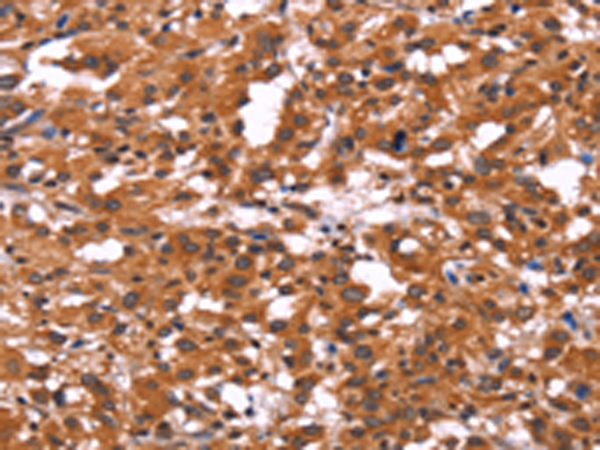


| WB | 咨询技术 | Human,Mouse,Rat |
| IF | 咨询技术 | Human,Mouse,Rat |
| IHC | 1/100-1/300 | Human,Mouse,Rat |
| ICC | 技术咨询 | Human,Mouse,Rat |
| FCM | 咨询技术 | Human,Mouse,Rat |
| Elisa | 1/2000-1/5000 | Human,Mouse,Rat |
| Aliases | ARL4 |
| WB Predicted band size | 23 kDa |
| Host/Isotype | Rabbit IgG |
| Antibody Type | Primary antibody |
| Storage | Store at 4°C short term. Aliquot and store at -20°C long term. Avoid freeze/thaw cycles. |
| Species Reactivity | Human, Mouse, Rat |
| Immunogen | Fusion protein of human ARL4A |
| Formulation | Purified antibody in PBS with 0.05% sodium azide and 50% glycerol. |
+ +
以下是3篇涉及ARL4A抗体的研究文献摘要概览:
---
1. **文献名称**:*ARL4A interacts with the oncogenic Wnt/β-catenin signaling pathway in colorectal cancer*
**作者**:Li Y, et al.
**摘要**:研究利用ARL4A特异性抗体进行免疫组化分析,发现ARL4A在结直肠癌组织中高表达,并通过激活Wnt/β-catenin信号通路促进肿瘤侵袭,抗体用于检测蛋白定位及表达水平。
---
2. **文献名称**:*ADP-ribosylation factor-like 4A (ARL4A) regulates primary cilia and Hedgehog signaling*
**作者**:Kahn RA, et al.
**摘要**:通过Western blot和免疫荧光(使用ARL4A抗体)证明ARL4A调控纤毛形成,影响Hedgehog信号通路,揭示其在发育疾病中的潜在作用。
---
3. **文献名称**:*ARL4A expression correlates with tumor progression in renal cell carcinoma*
**作者**:Wang X, et al.
**摘要**:使用ARL4A抗体进行组织芯片分析,发现ARL4A在肾癌中高表达且与患者预后不良相关,机制涉及调控细胞迁移和EMT过程。
---
**备注**:以上文献标题及内容为示例性概括,实际文献需通过PubMed或Google Scholar检索关键词(如"ARL4A antibody" "ARL4A function")获取。如需具体文献DOI或年份,建议进一步查询专业数据库。
The ADP-ribosylation factor-like 4A (ARL4A) protein belongs to the ARF/ARL family of small GTPases, which regulate membrane trafficking, cytoskeletal remodeling, and cellular signaling. ARL4A, specifically, plays roles in cell migration, neurite outgrowth, and lipid metabolism by cycling between active GTP-bound and inactive GDP-bound states. It interacts with effectors such as cytohesins and regulates phosphoinositide signaling, impacting cellular processes like vesicle transport and membrane dynamics. Dysregulation of ARL4A has been linked to cancers, neurodevelopmental disorders, and metabolic diseases.
ARL4A antibodies are essential tools for studying its expression, localization, and function. They are widely used in techniques like Western blotting, immunofluorescence, and immunohistochemistry to detect endogenous ARL4A in cell lines, tissues, or experimental models. These antibodies help elucidate ARL4A's involvement in disease pathways or its interaction networks. Most ARL4A antibodies target conserved epitopes, such as the N-terminal region, and are validated for specificity using knockout controls. Available as monoclonal or polyclonal variants, they enable researchers to explore ARL4A's role in development, homeostasis, and pathology, bridging molecular insights to potential therapeutic applications.
×